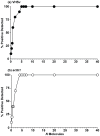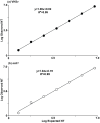Accurate detection and quantification of the fish viral hemorrhagic Septicemia virus (VHSv) with a two-color fluorometric real-time PCR assay
- PMID: 23977162
- PMCID: PMC3748128
- DOI: 10.1371/journal.pone.0071851
Accurate detection and quantification of the fish viral hemorrhagic Septicemia virus (VHSv) with a two-color fluorometric real-time PCR assay
Abstract
Viral Hemorrhagic Septicemia virus (VHSv) is one of the world's most serious fish pathogens, infecting >80 marine, freshwater, and estuarine fish species from Eurasia and North America. A novel and especially virulent strain - IVb - appeared in the Great Lakes in 2003, has killed many game fish species in a series of outbreaks in subsequent years, and shut down interstate transport of baitfish. Cell culture is the diagnostic method approved by the USDA-APHIS, which takes a month or longer, lacks sensitivity, and does not quantify the amount of virus. We thus present a novel, easy, rapid, and highly sensitive real-time quantitative reverse transcription PCR (qRT-PCR) assay that incorporates synthetic competitive template internal standards for quality control to circumvent false negative results. Results demonstrate high signal-to-analyte response (slope = 1.00±0.02) and a linear dynamic range that spans seven orders of magnitude (R(2) = 0.99), ranging from 6 to 6,000,000 molecules. Infected fishes are found to harbor levels of virus that range to 1,200,000 VHSv molecules/10(6) actb1 molecules with 1,000 being a rough cut-off for clinical signs of disease. This new assay is rapid, inexpensive, and has significantly greater accuracy than other published qRT-PCR tests and traditional cell culture diagnostics.
Conflict of interest statement
Figures






Similar articles
-
A new StaRT-PCR approach to detect and quantify fish Viral Hemorrhagic Septicemia virus (VHSv): enhanced quality control with internal standards.J Virol Methods. 2013 Apr;189(1):129-42. doi: 10.1016/j.jviromet.2013.01.006. Epub 2013 Jan 30. J Virol Methods. 2013. PMID: 23375747
-
Comparison of quantitative RT-PCR with cell culture to detect viral hemorrhagic septicemia virus (VHSV) IVb infections in the Great Lakes.J Aquat Anim Health. 2010 Mar;22(1):50-61. doi: 10.1577/H09-028.1. J Aquat Anim Health. 2010. PMID: 20575365
-
Evaluation of inactivated snakehead rhabdovirus as an internal positive control for RT-qPCR diagnosis of viral hemorrhagic septicemia virus in fish.J Virol Methods. 2025 May;334:115128. doi: 10.1016/j.jviromet.2025.115128. Epub 2025 Feb 17. J Virol Methods. 2025. PMID: 39971008
-
Detection and surveillance of viral hemorrhagic septicemia virus using real-time RT-PCR. II. Diagnostic evaluation of two protocols.Dis Aquat Organ. 2014 Aug 21;111(1):15-22. doi: 10.3354/dao02758. Dis Aquat Organ. 2014. PMID: 25144113
-
Viral haemorrhagic septicaemia virus in marine fish and its implications for fish farming--a review.J Fish Dis. 2005 Sep;28(9):509-29. doi: 10.1111/j.1365-2761.2005.00654.x. J Fish Dis. 2005. PMID: 16266325 Review.
Cited by
-
Gene Diversification of an Emerging Pathogen: A Decade of Mutation in a Novel Fish Viral Hemorrhagic Septicemia (VHS) Substrain since Its First Appearance in the Laurentian Great Lakes.PLoS One. 2015 Aug 27;10(8):e0135146. doi: 10.1371/journal.pone.0135146. eCollection 2015. PLoS One. 2015. PMID: 26313549 Free PMC article.
-
Evolutionary trajectory of fish Piscine novirhabdovirus (=Viral Hemorrhagic Septicemia Virus) across its Laurentian Great Lakes history: Spatial and temporal diversification.Ecol Evol. 2020 Sep 2;10(18):9740-9775. doi: 10.1002/ece3.6611. eCollection 2020 Sep. Ecol Evol. 2020. PMID: 33005343 Free PMC article.
References
-
- Rao JR, Fleming CC, Moore JE (2006) Molecular Diagnostics Current Technology and Applications. Horizon Bioscience, Norfolk, Norwich, United Kingdom.
-
- Coutlée F, Viscidi RP, Saint-Antoine P, Kessous A, Yolken RH (1991) The polymerase chain reaction: a new tool for the understanding and diagnosis of HIV-1 infection at the molecular level. Mol Cell Probe 5: 241–259. - PubMed
-
- Ellis JS, Zambon MC (2002) Molecular diagnosis of influenza. Rev Med Virol 12: 375–389. - PubMed
-
- Chai Z, Ma W, Fu F, Lang Y, Wang W, et al. (2013) A SYBR Green-based real-time RT-PCR assay for simple and rapid detection and differentiation of highly pathogenic and classical type 2 porcine reproductive and respiratory syndrome virus circulating in China. Arch Virol 158: 407–415. - PubMed
Publication types
MeSH terms
Substances
Grants and funding
LinkOut - more resources
Full Text Sources
Other Literature Sources

